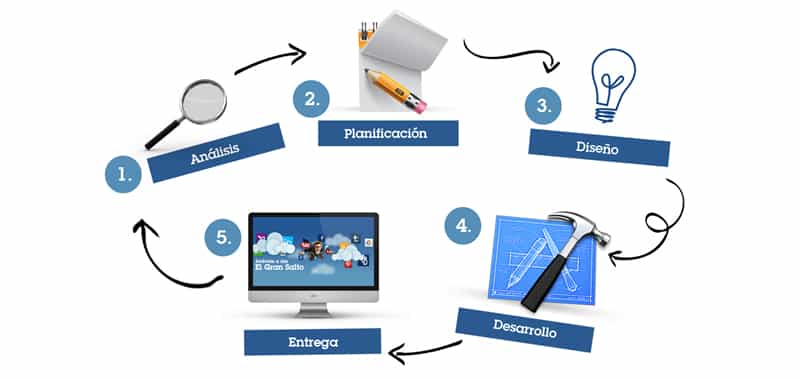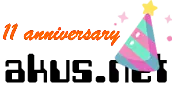Processes in planning and creating a website
When developing a Web page, it is necessary to clarify and define in a basic way the existing expectations regarding the Web application.

Analysis Phase
At the time of the development of a Web site should start by responding to a very specific group of questions, which will clarify and define in a basic way the existing expectations about the Web application and Interaction that will be generated.
These questions could be the following:
- Is the website really needed?
- What is the website needed for?
- What will the users search for on the website?
- What image do you want to project with the website to users?
- What interactive services will be integrated through the website?
- What resources are available for the development of the website?
- How much time should be invested in the development of the website?
- What impact will the website have on users?
Planning Phase
Every project has a planning phase. It should define what are the technical requirements for this purpose, who will be the team members, select the structure, plan a well-organized site, and conduct comparative marketing studies.
Selection of the Right Equipment
"The team work environment arises from the need to segment the production process in several different functions" (Green, Chilcott and Flick, 2003)
Each member of the Web team must be trained in their field of work (the presence or level of experience of certain team members may vary depending on the project.) A list of members that could be part of this team is suggested, from this list They extracted the following:
- Project manager: In charge of the supervision and control of the rest of the team. Acts as a link between the user and the other members
- Producer: This is responsible for establishing the appearance, perception and functionality of the site
- Editor: Help to establish and maintain the style, in addition to the integrity of the site. It has the responsibility to control the correction and the flow of text and in some cases the multimedia content of the site
- Writer: Writers should be interested in the technical details and the incorporation to the development of standards regarding the site, use of the appropriate words, spelling and grammar. It is necessary that the writer has knowledge of HTML, or tools with FrontPage or another application
- Database Designer: Develops the databases that manages the website, is responsible for defining their relationships
- Scripting designer: Work in conjunction with the database designer. Develops and debug scripts, Activex components and other interactive elements on the Web
- Graphic Designer: Is responsible for creating the visual files of the site, can also be responsible for the creation of sound and film files. Work with images and small programming tasks
- Hardware Technician: Configure, test, operate and maintain the computers, printers and machines necessary for the execution and maintenance of the site
- Testing technician: If a large or complex site is available, the incorporation of a test technician to the team can be helpful. His job is to ensure that everything works as it should, is responsible for testing the elements of all pages
Although these functions could be taken as essential, the structure will always be determined by the scope of the project.
Benchmarking
It is a way to detail, observe and evaluate all those Web pages rated as the best on the network, in order to design a way to create a product of high quality, productivity and competitiveness.
A practical way to perform benchmarking is to ask a series of questions when visiting the pages that have been selected as the best in the industry, Morris and Dickson (2002) suggest the following:
- What are the objectives of the site?
- How long does it take to load?
- Was it downloaded in a logical order?
- Is it an interesting website?
- How are the graphics?
- Does it reflect the gender of the company or company?
- Is it easy to use and is it comfortable to navigate in it?
- Is the content structured logically?
- Are there too many or insufficient levels of information?
- Overall, is the site a success?
Investment costs
When planning a website, a feasibility study must be conducted that reflects the financial cost to invest, and that covers time, personnel, Web hosting, domain, licenses if needed, and maintenance.
Having a method of time control becomes relevant in Web development, as in other projects, since time involves money. A technique for controlling the cost of a certain activity is the agenda system, which consists of dividing each hour into six-minute segments called units, and it is from the number of units per activity that the cost of the activity will be measured.
Benefits to obtain
The implementation of the site is not everything, the planning of the development of a website should cover aspects such as benefits to acquire with the operation of it. Before establishing the development of a website, the return time of the investment should be estimated, since in that tangible way, such as a monetary return, or intangible as the improvement of the interpersonal relationships of the organization.
Content Phase
Basically, the success of a website is due to its content. The content of the site will probably be a combination of the information that is currently owned and from which it will have to be created.
It is convenient to present a content according to the objectives set to develop the site, and that the information to be captured covers the needs and interests of the target audience.
Design phase
Web design is an extensive work, an extensive and detailed work, since it covers not only the interaction of multiple elements, such as multimedia technology (audio, sound, images, animations, among others); rather, it also includes its integration with a logical structure based on the purpose of the site. Representing a task that goes beyond the simple need and concerns of its potential users.
When designing Web sites, it is necessary to take into account aspects such as usability and accessibility.
Usability
Referring to the time, effort and capacity required by the visitor, to reach a certain level of adaptation to the system, this may be linked at times to the number of steps necessary to achieve a certain activity, and to the level of knowledge required by users for the use of the application.
Accessibility
A website is developed with the idea that it is seen by the largest number of visitors, but it must be borne in mind that each of these can access information with computers, browsers and different languages, these factors may prevent the site from can be appreciated in its entirety.
Romero (1999) points out three fundamental areas to determine the accessibility of a Web site, these are:
Accessibility to the computer: Referring to the hardware capacity that must be counted for the use of the Web application, the ideal in this area is that the application adapts to the computer whatever it may be.
Accessibility of the browser used: Sometimes content itself is displayed in different ways in different web browsers, it is recommended to use a design that can be viewed in most browsers and adheres to the standard.
Web page design accessibility: Users may have some features of Web browsers disabled, which could affect the correct visualization of the content of the Web site.
Programming phase
This stage corresponds to the use of Web programming tools. At this point it is essential to select the programming languages in which the website will be developed, the database to define which content of the site will be static and which will be dynamic.
Once these criteria have been defined, we move on to a stage called three-phase architecture, which exposes the following:
Databases: The database is designed and created.
Intermediary programming: Programs or codes that will be executed on the Web server. Here the communication between the database and the interface will be established.
Interface: Programs and codes that will display the content to users through the Web browser. It refers to applications that the user will visualize and through which he will operate with it.
Test Phase
Extensive tests are carried out to ensure the perfect functioning of the website with users who will use the site:
- Checking in browsers: The first and most important step is to check that the pages can be displayed correctly in different browsers.
- Detect broken links: It is necessary to detect documents that exist on the site but are not connected through links; they must be repaired or eliminated if they are not necessary since they occupy space on the server and tend to create confusion
- Check download time: One of the key points in the success of a website is its download speed, based on it is recommended a minimum download time
At this point, administrators must receive training to carry out their tasks.
Market and Advertising Phase
In this phase, the International Author Rights must be taken into account, by which:
- All copies made include copyright
- Developer credits are attached to the site, or a link that allows users to contact them
Then the domain of the site is defined, it is verified that it is available to be able to register it, and the files are transferred to the remote server by FTP, or from the server page. You must verify that all files are in their corresponding folder on the Web.
After the Web has been published, its dissemination depends on the advertising that can be given through the organization's stationery, through banners on specific sites, through search engines and others.
CITE ARTICLE
For homework, research, thesis, books, magazines, blogs or academic articles
APA Format Reference:
Delgado, Hugo. (2019).
Processes in planning and creating a website.
Retrieved Nov 11, 2025, from
https://disenowebakus.net/en/processes-identification






